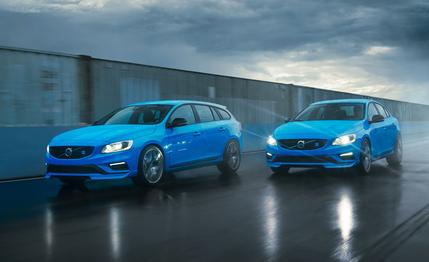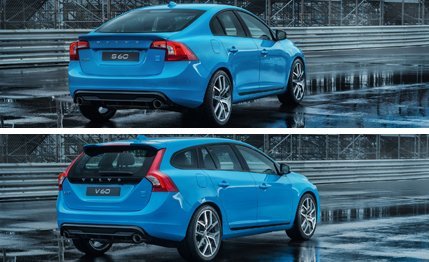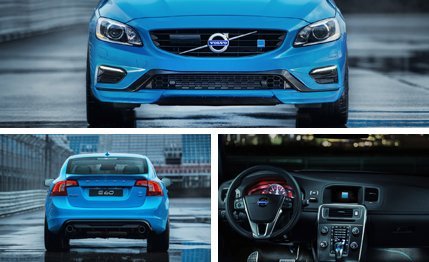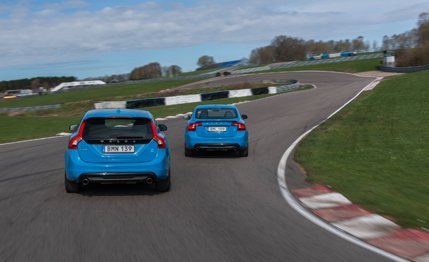
 First Drive Review
First Drive Review
One hundred and twenty. That’s how many Ferrari LaFerraris are destined for North America. It’s also how many Polestar-branded V60 wagons and S60 sedans Volvo will send to the U.S. starting later this month. So the odds of spotting one in the wild are roughly equal.
The comparability ends there, of course, although Volvo touts its limited-edition special as a driver’s car. The 80 Volvo wagons and 40 sedans—any color you want as long as you want black or Polestar’s signature Rebel Blue—won’t be quite as rare as Maranello’s latest 499-edition hypercar. There are 750 of the Swedish specials being built for worldwide distribution, including a batch for Canada. The American allotment amounts to less than a third of the number of U.S. Volvo dealerships, so the cluster of eight we encountered in far southern Sweden for a couple days of hard driving, including a racetrack interlude, might be the biggest gathering ever seen outside the loading docks.
If you’re hunting this unicorn, look for the front splitter, rear spoiler, rear diffuser, model-specific 20-inch wheels, black grille, and Polestar badges liberally scattered all over. Inside, there’s some nice blue stitching on the leather upholstery and steering wheel, carbon-fiber-esque trim on the center console, a supportive seat, and more brag badges, but the Volvo’s instrument cluster and conservative interior design survive the transformation.


This is the first full-car collaboration between Volvo and the road-car performance division of its Swedish racing-partner Polestar. The S60/V60 Polestar is built entirely on the factory assembly line, the better to install the stiffer bushings, braces, and mounts that help sharpen its reflexes. Moreover, despite a power boost to 345 horsepower and extensive suspension, brake, aerodynamic, and calibration tweaks, the Polestars merit the same fuel-economy, emissions, and crash-test ratings as those of the all-wheel-drive R-Design models on which they’re based. Volvo insisted.
Left to their own devices, the hard-core racers at Polestar might have gone in for something more akin to the wild 505-hp S60 prototype the company was showing 18 months ago, but the social-minded Swedes who still run the Chinese-owned (Geely) company didn’t want a track-day special for Touring Car fan boys. They wanted a Volvo that would appeal to mature drivers of a serious bent, the sort who might otherwise shop German brands. The marketing tagline is “when driving matters,” by which we infer the unintended admission that for most Volvo owners, most of the time, it doesn’t, at least not as much as does the firm’s crash-it-and-walk-away reputation.
Volvo’s trump card here is that the Swedes will sell Americans their go-fast bits wrapped in a pretty wagon body, catering to a niche most others snub—Audi reserves its S/RS 4 Avants for Europe, preferring, as does BMW, to offer us warmed-over crossovers. Cadillac’s CTS-V wagon dies after 2014, and although the Mercedes E63 AMG wagon is the genuine go-fast-with-cargo article, its sticker starts north of $100,000. Volvo hasn’t set final pricing on the Polestar as of this writing, but you won’t be far off calling it a $60,000 car—a bit less than the Cadillac’s base price. That’s fully loaded with only your choice of the two body styles and two colors.


Honed Hardware
Development of the 2015 Polestar models began several years ago and ultimately called for 76 changes from S60/V60 R specification. The project included, along the way, an even more limited edition of 100 prototypes (50 based on the 2013 model, 50 on the face-lifted-for-2014 version) sold in Australia, where Polestar sought to capitalize on its incursion into the Holden-and-Ford-dominated V8 Supercar racing series. Beware, Down Under speeders. The police in Victoria ended up with one. Henrik Fries, Polestar’s project manager on the program, says what they learned from the Aussie edition was that the chassis wanted more tire: “We had 19-inch wheels on the Australian car, but we figured out as we tuned and calibrated it that we needed more grip and a shorter-profile sidewall.” The result was 20-inch wheels wearing Z-rated Michelin Pilot Super Sports, size 245/35, with a tread compound akin to that chosen by Koenigsegg. Volvo’s insistence that the Polestar be an all-year, all-weather car means owners will be offered a narrower winter tire, too, on 19- or 20-inch rims.


Polestar managing director Hans Bååth says the focus of the project was to enhance handling and driving feel more than straight-line performance. Seriously grippy rubber is a good start, but ride quality had to stay within the comfort zone, and the car’s best attribute is a refined mix of responsiveness and comfort. The aforementioned stiffer bushings and spring mounts, springs 80 percent stiffer than the stock edition’s, a cross-tower carbon-fiber stiffener under the hood, and short tire sidewalls could have ruined the ride. The solution is a set of dampers Polestar developed with racing-shock company Öhlins, with a blow-off valve to release pressure on the up- and down-strokes when encountering rapid, high-frequency motions like those induced by rough roads. “Electronic adjustable shocks don't react as quickly as these,” Fries says.
Seeking out the roughest pavement around, we never found the ride in this Volvo too jarring or firm to consider taking Mom over to Ikea for meatballs. The Öhlins are probably as pricey as the electro-wonders used by competitors, and even adjustable. Owners with particular needs can make the adjustment, but Volvo recommends having it done at the dealership.